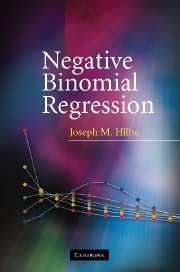Book contents
- Frontmatter
- Contents
- Preface
- Introduction
- 1 Overview of count response models
- 2 Methods of estimation
- 3 Poisson regression
- 4 Overdispersion
- 5 Negative binomial regression
- 6 Negative binomial regression: modeling
- 7 Alternative variance parameterizations
- 8 Problems with zero counts
- 9 Negative binomial with censoring, truncation, and sample selection
- 10 Negative binomial panel models
- Appendix A Negative binomial log-likelihood functions
- Appendix B Deviance functions
- Appendix C Stata negative binominal – ML algorithm
- Appendix D Negative binomial variance functions
- Appendix E Data sets
- References
- Author Index
- Subject Index
2 - Methods of estimation
Published online by Cambridge University Press: 05 June 2012
- Frontmatter
- Contents
- Preface
- Introduction
- 1 Overview of count response models
- 2 Methods of estimation
- 3 Poisson regression
- 4 Overdispersion
- 5 Negative binomial regression
- 6 Negative binomial regression: modeling
- 7 Alternative variance parameterizations
- 8 Problems with zero counts
- 9 Negative binomial with censoring, truncation, and sample selection
- 10 Negative binomial panel models
- Appendix A Negative binomial log-likelihood functions
- Appendix B Deviance functions
- Appendix C Stata negative binominal – ML algorithm
- Appendix D Negative binomial variance functions
- Appendix E Data sets
- References
- Author Index
- Subject Index
Summary
Two general methods are used to estimate count response models: (1) iteratively re-weighted least squares algorithm based on the method of Fisher scoring, and (2) a maximum likelihood Newton–Raphson type algorithm. Although the maximum likelihood approach was first used with both the Poisson and negative binomial, we shall discuss it following our examination of IRLS. We do this for strictly pedagogical purposes, as will become evident as we progress.
Derivation of the IRLS algorithm
The traditional generalized linear models (GLM) algorithm, from the time it was implemented in GLIM (generalized linear interactive modeling) through its current implementations in Stata, S-Plus, and other GLM software, uses some version of an IRLS estimating algorithm. This method arises from Fisher scoring, which substitutes the expected Hessian matrix for the observed Hessian matrix in a Taylor series defined updating step for a solution of the estimating equation. The resulting Newton–Raphson or updating equation for the regression coefficients may be written in terms of ordinary least squares (OLS) due to the simplification afforded by Fisher scoring. The reason for its initial development had much to do with the difficulty of modeling individual GLM models using full maximum likelihood algorithms. In the late 1960s and early 1970s, statistical software was limited to mainframe batch runs. That is, one wrote an estimating algorithm in a higher programming language such as FORTRAN, tied it together with data stored on cards, and submitted it to a mainframe, which usually resided at a remote site.
- Type
- Chapter
- Information
- Negative Binomial Regression , pp. 19 - 38Publisher: Cambridge University PressPrint publication year: 2007

